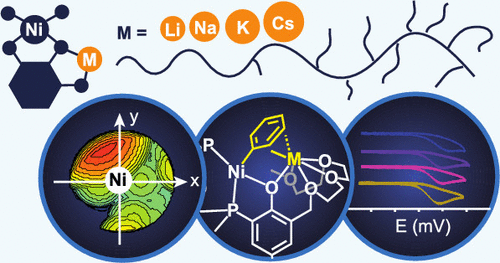当前位置:
X-MOL 学术
›
ACS Catal.
›
论文详情
Our official English website, www.x-mol.net, welcomes your feedback! (Note: you will need to create a separate account there.)
Elucidating Secondary Metal Cation Effects on Nickel Olefin Polymerization Catalysts
ACS Catalysis ( IF 12.9 ) Pub Date : 2020-08-11 , DOI: 10.1021/acscatal.0c02949 Thi V. Tran 1 , Lucas J. Karas 1 , Judy I. Wu 1 , Loi H. Do 1
ACS Catalysis ( IF 12.9 ) Pub Date : 2020-08-11 , DOI: 10.1021/acscatal.0c02949 Thi V. Tran 1 , Lucas J. Karas 1 , Judy I. Wu 1 , Loi H. Do 1
Affiliation

|
Secondary metal cations, such as alkali and transition metal ions, have been shown to enhance the catalytic performance of nickel and palladium olefin polymerization catalysts. Their beneficial effects can manifest in different ways, such as increasing rates of polymerization, altering polymer microstructures, enhancing catalyst thermal stability, or a combination of these effects. We have systematically quantified secondary metal ion influences on nickel phenoxyphosphine polyethylene glycol (PEG) complexes. We demonstrate that cation tuning could readily achieve three-dimensional structures and electronic environments that are not easily accessible through conventional ligand tuning. This study led to the development of extremely active ethylene polymerization catalysts. For example, the nickel–lithium complex gave activity and turnover number as high as 7.0 × 104 kg PE/mol Ni·h and 2.5 × 106 mol ethylene/mol Ni, respectively, and the nickel–cesium complex showed unusual thermal stability up to 90 °C (activity = 2.3 × 104 kg/mol h, turnover number = ∼4.1 × 105 mol ethylene/mol Ni, and Mn = 1.6 × 104 g/mol). We provide both experimental and computational data showing that secondary metals impact the relative stability of cis and trans isomers, which is a phenomenon not shown previously. Unlike in our earlier work, which was limited by poor nuclearity control and/or secondary metals that were too far from the catalyst center, the nickel phenoxyphosphine–PEG complex is an ideal platform for future studies of cation-controlled polymerization.
中文翻译:

阐明二级金属阳离子对镍烯烃聚合催化剂的影响
已显示出诸如碱金属和过渡金属离子之类的仲金属阳离子可增强镍和钯烯烃聚合催化剂的催化性能。它们的有益作用可以以不同的方式体现出来,例如提高聚合速率,改变聚合物的微观结构,增强催化剂的热稳定性或这些作用的组合。我们已经系统地量化了仲金属离子对镍苯氧基膦聚乙二醇(PEG)配合物的影响。我们证明阳离子调节可以很容易地实现三维结构和电子环境,这是常规配体调节不容易获得的。这项研究导致了极活泼的乙烯聚合催化剂的发展。例如,PE / mol Ni·h为4 kg PE / mol Ni / h,乙烯/ mol Ni为2.5×10 6 mol,镍铯络合物在高达90°C的温度下显示出异常的热稳定性(活性= 2.3×10 4 kg / mol h,周转数=大约4.1m×10 5摩尔乙烯/摩尔的Ni,和中号ñ = 1.6×10 4克/摩尔)。我们提供的实验和计算数据均表明,仲金属会影响顺式和反式异构体的相对稳定性,这是以前未显示的现象。与我们早期的工作(由于核控制不佳和/或远离催化剂中心的仲金属所限制)不同,镍苯氧基膦-PEG配合物是阳离子控制聚合未来研究的理想平台。
更新日期:2020-09-20
中文翻译:

阐明二级金属阳离子对镍烯烃聚合催化剂的影响
已显示出诸如碱金属和过渡金属离子之类的仲金属阳离子可增强镍和钯烯烃聚合催化剂的催化性能。它们的有益作用可以以不同的方式体现出来,例如提高聚合速率,改变聚合物的微观结构,增强催化剂的热稳定性或这些作用的组合。我们已经系统地量化了仲金属离子对镍苯氧基膦聚乙二醇(PEG)配合物的影响。我们证明阳离子调节可以很容易地实现三维结构和电子环境,这是常规配体调节不容易获得的。这项研究导致了极活泼的乙烯聚合催化剂的发展。例如,PE / mol Ni·h为4 kg PE / mol Ni / h,乙烯/ mol Ni为2.5×10 6 mol,镍铯络合物在高达90°C的温度下显示出异常的热稳定性(活性= 2.3×10 4 kg / mol h,周转数=大约4.1m×10 5摩尔乙烯/摩尔的Ni,和中号ñ = 1.6×10 4克/摩尔)。我们提供的实验和计算数据均表明,仲金属会影响顺式和反式异构体的相对稳定性,这是以前未显示的现象。与我们早期的工作(由于核控制不佳和/或远离催化剂中心的仲金属所限制)不同,镍苯氧基膦-PEG配合物是阳离子控制聚合未来研究的理想平台。


























 京公网安备 11010802027423号
京公网安备 11010802027423号